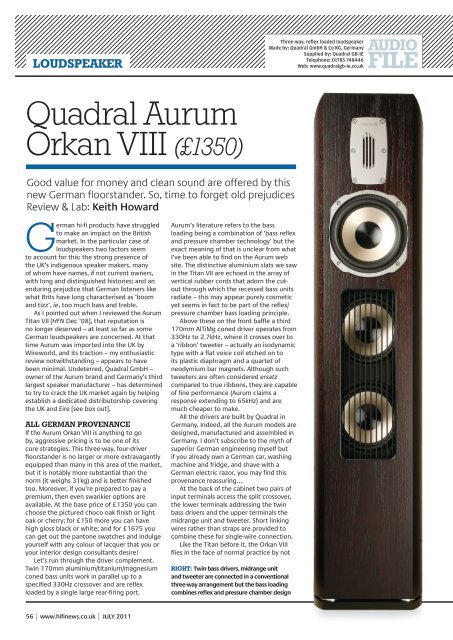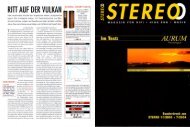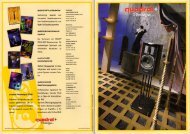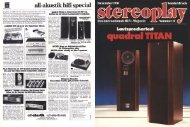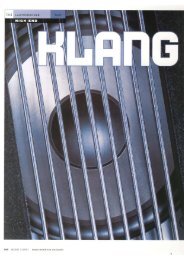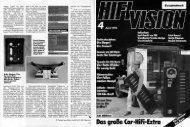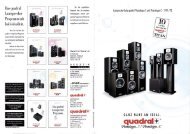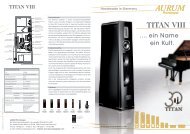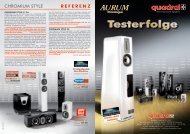You also want an ePaper? Increase the reach of your titles
YUMPU automatically turns print PDFs into web optimized ePapers that Google loves.
LOUDSPEAKER<br />
Three-way, reflex loaded loudspeaker<br />
Made by: <strong>Quadral</strong> GmbH & Co KG, Germany<br />
Supplied by: <strong>Quadral</strong> GB-IE<br />
Telephone: 01785 748446<br />
Web: www.quadralgb-ie.co.uk<br />
<strong>Quadral</strong> <strong>Aurum</strong><br />
<strong>Orkan</strong> <strong>VIII</strong> (£1350)<br />
Good value for money and clean sound are offered by this<br />
new German floorstander. So, time to forget old prejudices<br />
Review & Lab: Keith Howard<br />
German hi-fi products have struggled<br />
to make an impact on the British<br />
market. In the particular case of<br />
loudspeakers two factors seem<br />
to account for this: the strong presence of<br />
the UK’s indigenous speaker makers, many<br />
of whom have names, if not current owners,<br />
with long and distinguished histories; and an<br />
enduring prejudice that German listeners like<br />
what Brits have long characterised as ‘boom<br />
and tizz’, ie, too much bass and treble.<br />
As I pointed out when I reviewed the <strong>Aurum</strong><br />
Titan VII [HFN Dec ’08], that reputation is<br />
no longer deserved – at least so far as some<br />
German loudspeakers are concerned. At that<br />
time <strong>Aurum</strong> was imported into the UK by<br />
Wireworld, and its traction – my enthusiastic<br />
review notwithstanding – appears to have<br />
been minimal. Undeterred, <strong>Quadral</strong> GmbH –<br />
owner of the <strong>Aurum</strong> brand and Germany’s third<br />
largest speaker manufacturer – has determined<br />
to try to crack the UK market again by helping<br />
establish a dedicated distributorship covering<br />
the UK and Eire [see box out].<br />
all german provenance<br />
If the <strong>Aurum</strong> <strong>Orkan</strong> <strong>VIII</strong> is anything to go<br />
by, aggressive pricing is to be one of its<br />
core strategies. This three-way, four-driver<br />
floorstander is no larger or more extravagantly<br />
equipped than many in this area of the market,<br />
but it is notably more substantial than the<br />
norm (it weighs 31kg) and is better finished<br />
too. Moreover, if you’re prepared to pay a<br />
premium, then even swankier options are<br />
available. At the base price of £1350 you can<br />
choose the pictured choco oak finish or light<br />
oak or cherry; for £150 more you can have<br />
high gloss black or white; and for £1675 you<br />
can get out the pantone swatches and indulge<br />
yourself with any colour of lacquer that you or<br />
your interior design consultants desire!<br />
Let’s run through the driver complement.<br />
Twin 170mm aluminium/titanium/magnesium<br />
coned bass units work in parallel up to a<br />
specified 330Hz crossover and are reflex<br />
loaded by a single large rear-firing port.<br />
<strong>Aurum</strong>’s literature refers to the bass<br />
loading being a combination of ‘bass reflex<br />
and pressure chamber technology’ but the<br />
exact meaning of that is unclear from what<br />
I’ve been able to find on the <strong>Aurum</strong> web<br />
site. The distinctive aluminium slats we saw<br />
in the Titan VII are echoed in the array of<br />
vertical rubber cords that adorn the cutout<br />
through which the recessed bass units<br />
radiate – this may appear purely cosmetic<br />
yet seems in fact to be part of the reflex/<br />
pressure chamber bass loading principle.<br />
Above these on the front baffle a third<br />
170mm AlTiMg coned driver operates from<br />
330Hz to 2.7kHz, where it crosses over to<br />
a ‘ribbon’ tweeter – actually an isodynamic<br />
type with a flat voice coil etched on to<br />
its plastic diaphragm and a quartet of<br />
neodymium bar magnets. Although such<br />
tweeters are often considered ersatz<br />
compared to true ribbons, they are capable<br />
of fine performance (<strong>Aurum</strong> claims a<br />
response extending to 65kHz) and are<br />
much cheaper to make.<br />
All the drivers are built by <strong>Quadral</strong> in<br />
Germany. Indeed, all the <strong>Aurum</strong> models are<br />
designed, manufactured and assembled in<br />
Germany. I don’t subscribe to the myth of<br />
superior German engineering myself but<br />
if you already own a German car, washing<br />
machine and fridge, and shave with a<br />
German electric razor, you may find this<br />
provenance reassuring…<br />
At the back of the cabinet two pairs of<br />
input terminals access the split crossover,<br />
the lower terminals addressing the twin<br />
bass drivers and the upper terminals the<br />
midrange unit and tweeter. Short linking<br />
wires rather than straps are provided to<br />
combine these for single-wire connection.<br />
Like the Titan before it, the <strong>Orkan</strong> <strong>VIII</strong><br />
flies in the face of normal practice by not<br />
RIGHT: Twin bass drivers, midrange unit<br />
and tweeter are connected in a conventional<br />
three-way arrangement but the bass loading<br />
combines reflex and pressure chamber design<br />
56 | www.hifinews.co.uk | JULY 2011
QuadrAl – a brIEf history<br />
The All Group – comprising All-electronic and All-akustik divisions – was<br />
founded by four business partners in Hannover in 1972, the latter arm<br />
introducing its first <strong>Quadral</strong>-branded loudspeaker, the Titan, before the<br />
end of that decade. Now in its seventh generation, the Titan remains<br />
<strong>Quadral</strong>’s flagship speaker and continues to feature a ribbon tweeter like<br />
the original, although not its transmission-line bass loading. All ten of the<br />
company’s top, audiophile speaker products, though, are now sold under<br />
the <strong>Aurum</strong> brand name, which signifies that they are hand-built entirely in<br />
Germany, whereas the second-string <strong>Quadral</strong>-branded range – which has<br />
a separate web site – is only partly built there. <strong>Quadral</strong>’s GB and Ireland<br />
distributorship, based in Stafford in the West Midlands, was launched<br />
earlier this year. Although funded independently from <strong>Quadral</strong> in Germany,<br />
<strong>Quadral</strong> GB-IE claims a special relationship with the German company that<br />
will, for example, see the GB-IE operation assist in developing <strong>Quadral</strong>’s<br />
presence in other English-speaking markets such as the USA.<br />
providing floor spikes, or any inserts<br />
into which spikes could be screwed.<br />
In the case of the Titan its weight was<br />
sufficient and its base large enough,<br />
arguably, to get away with this –<br />
although I still preferred its sound<br />
when placed on spiked platforms. The<br />
<strong>Orkan</strong> <strong>VIII</strong> is neither heavy enough<br />
nor sufficiently large of footprint for<br />
the absence of spiking provision to be<br />
justifiable. So with carpet you must<br />
either forgo spiking and accept the<br />
attendant sacrifice in sound quality<br />
or deploy spiked platforms which will<br />
detract somewhat from the <strong>Orkan</strong><br />
<strong>VIII</strong>’s smart looks.<br />
making distinctions<br />
In many respects the<br />
<strong>Orkan</strong> <strong>VIII</strong> delivers<br />
a performance<br />
concomitant with its<br />
classy appearance.<br />
It is tonally neutral,<br />
easily outdoing<br />
the Titan VII in this<br />
respect, has tuneful,<br />
well-controlled bass and, thanks<br />
to its leaf tweeter, an unusually<br />
clean and clear treble. It may seem<br />
churlish to ask for more at this<br />
price but the one reservation I have<br />
concerns how these elements are<br />
melded together. All the best hi-fi<br />
products are greater than the sum<br />
of their parts or – as we used to<br />
express it – good at covering their<br />
tracks. Failings are easily forgotten,<br />
or at least forgiven, because of the<br />
cohesiveness of the overall sound.<br />
This, I feel, the <strong>Orkan</strong> doesn’t<br />
quite achieve. As that description<br />
probably suggests, it isn’t an easy<br />
characteristic to put your finger on<br />
– particularly when certain aspects of the<br />
<strong>Orkan</strong>’s performance are so laudable.<br />
I’m thinking here particularly of its<br />
fine treble, which really is a cut above<br />
that delivered by the average dome<br />
tweeter, metal dome or otherwise. Some<br />
ribbon tweeters – whether true ribbons<br />
or isodynamics like the <strong>Orkan</strong>’s – sound<br />
different but wrong, perhaps because<br />
they have poor distortion performance<br />
(see www.zaphaudio.com for some<br />
measurements of this). The <strong>Aurum</strong> tweeter,<br />
though, scintillates without drawing undue<br />
attention to itself.<br />
The <strong>Orkan</strong> <strong>VIII</strong> was notably good, for<br />
instance, at conveying and distinguishing<br />
the many different percussion instruments<br />
used in Henze’s Prison Song, ripped from<br />
what is comfortably<br />
‘The tweeter,<br />
scintillates, but<br />
without drawing<br />
attention to itself’<br />
the widest dynamic<br />
range DVD-A in my<br />
collection, Percussion<br />
XX [Arts 47558-6] –<br />
although it has, sadly,<br />
a plunging response<br />
above 20kHz. But it<br />
was noticeable from<br />
the first bars of this piece that the <strong>Orkan</strong><br />
<strong>VIII</strong> projects a somewhat narrower stereo<br />
image than I’m used to.<br />
Chesky’s natural, spacious recording of<br />
Christy Baron’s stylish take on ‘Got To Get<br />
You Into My Life’, which is even better as<br />
a 24/96 download from HDtracks, begins<br />
with a crisp but distanced drum break to<br />
the right of the soundstage and this too<br />
was handled with aplomb, sounding clean<br />
and energetic without any sense of being<br />
overcooked. Vocal sibilants were also<br />
lisp-free, as they were on every male and<br />
female voice I played, although this was<br />
another track in which the narrowed stereo<br />
image was apparent – a characteristic<br />
that may encourage you to dispose the<br />
JULY 2011 | www.hifinews.co.uk | 57
Lab<br />
report<br />
QUADRAL AURUM ORKAN <strong>VIII</strong> (£1350)<br />
<strong>Quadral</strong> specifies a sensitivity of 89dB, which is only a little<br />
optimistic according to our measured result of 88.4dB on<br />
pink noise input. This fairly high sensitivity is achieved in part<br />
through low impedance, the specified 4-8ohm range failing<br />
to encompass our measured minimum modulus of 2.9ohm<br />
at 37Hz. High impedance phase angles at low frequency also<br />
result in a low minimum EPDR (equivalent peak dissipation<br />
resistance) figure of 1.5ohm at 31Hz, although the next lowest<br />
dip of 1.9ohm at 90Hz may be more significant. Either way the<br />
<strong>Orkan</strong> <strong>VIII</strong> is a moderately challenging load to drive.<br />
Frequency response errors, 200Hz to 20kHz, of ±1.9dB<br />
and ±2.3dB for the review pair are unusually low, the on-axis<br />
frequency response trend [Graph 1, below] – measured on<br />
the axis of the ‘ribbon’ tweeter, with grille removed – being<br />
essentially flat other than for a marginal upward tilt towards<br />
high frequencies. Pair matching error, over the same frequency<br />
range, wasn’t so impressive at ±2.3dB but the largest<br />
disparities were above 6kHz, below which the matching was<br />
a more impressive ±1.1dB. Diffraction-corrected near-field<br />
measurement showed typical bass extension for a floorstander<br />
of this size/price, the –6dB frequency being 45Hz (re. 200Hz).<br />
Roll-off begins relatively slowly at about 90Hz, suggesting<br />
bass alignment has been optimised for transient response<br />
rather than ultimate extension. The cumulative spectral decay<br />
waterfall [Graph 2, below] shows fast energy decay from the<br />
tweeter, albeit marred in one of the test pair by a resonant<br />
ridge at about 6kHz. Below 3kHz the decay is lengthened by<br />
what look to be breakup modes in the midrange cone. KH<br />
ABOVE: Split crossover allows for bi-wiring or bi-amping, with single-wire<br />
connection realised using wire rather than metal links between the terminal posts<br />
speakers more widely than normal,<br />
if you’ve sufficient room.<br />
The Baron track also highlighted<br />
the <strong>Orkan</strong> <strong>VIII</strong>’s tuneful bass, which<br />
seems to have been aligned with<br />
more concern for clean transient<br />
performance than maximum<br />
extension. This was confirmed by<br />
the challenging ‘Annie’s Yellow Bag’<br />
from Gwyneth Herbert’s All The<br />
Ghosts [naimcd135], whose opening<br />
combination of bass and drums was<br />
well handled. Yet there was a sense<br />
that the pace and pizzazz of this<br />
piece were somewhat suppressed,<br />
so that it lacked the sheer energy it<br />
can and should exude.<br />
A touch of introversion<br />
This cuts to the heart of my<br />
reservations about the <strong>Orkan</strong> <strong>VIII</strong>:<br />
despite its neutral tonal balance,<br />
superior treble and melodic bass, it<br />
does sound a little lacking in drama,<br />
as a result of which it didn’t engage<br />
me as fervently as I hoped it would.<br />
There’s a reserve to its music-making<br />
that may appeal to some listeners<br />
but will leave others feeling a<br />
little distanced from the action. To<br />
anthropomorphise, the <strong>Orkan</strong> <strong>VIII</strong> is<br />
a touch ‘introverted’.<br />
One track that highlighted this<br />
was ‘Country Dreamers’, from the<br />
HDtracks 24/96 download of Wings’<br />
Band On The Run. Everything was<br />
there – the distorted opening<br />
refrain on acoustic guitar (or is it<br />
a mandolin or some such?), the<br />
descending bass notes, etc – but the<br />
rhythmic bounce was diminished.<br />
It’s as if the <strong>Orkan</strong> <strong>VIII</strong>’s midrange<br />
doesn’t project somehow – although<br />
there’s no evidence of any such lack<br />
in the measurements.<br />
Whatever the cause, this is<br />
part and parcel of the <strong>Orkan</strong> <strong>VIII</strong>’s<br />
makeup – something I experienced<br />
in varying degrees across a range of<br />
musical genres and recording styles<br />
from purist-miked solo tenor to<br />
studio assembled, reggae-influenced<br />
Grace Jones – complete with<br />
obligatory dynamic range squash.<br />
If you are going to live happily with<br />
the <strong>Orkan</strong> <strong>VIII</strong>, it is a character trait<br />
you will just have to accept.<br />
HI-FI NEWS VERDICT<br />
Impressively built and finished<br />
for the price, the <strong>Orkan</strong> <strong>VIII</strong> also<br />
boasts an unusually neutral<br />
tonal balance, notably clean<br />
treble courtesy of its isodynamic<br />
tweeter, and tuneful bass,<br />
perhaps because of the unusual<br />
loading of its twin LF drivers.<br />
All that’s lacking is the touch of<br />
magic necessary to turn these fine<br />
ingredients into a fully satisfying<br />
dish – a pinch of vitality to make<br />
the music live and breathe.<br />
Sound Quality: 77%<br />
0 - - - - - - - - 100<br />
ABOVE: Mild undulations aside, this <strong>Quadral</strong> speaker<br />
offers a very flat and usefully extended response<br />
dB<br />
- 6<br />
- 12<br />
- 18<br />
- 24<br />
- 30<br />
200 1000 10000<br />
Frequency in Hz >><br />
HI-FI NEWS SPECIFICATIONS<br />
0. 00<br />
1. 02<br />
2. 04<br />
3. 06<br />
4. 08<br />
5. 10 msec<br />
ABOVE: The cumulative spectral decay shows a mild<br />
tweeter resonance at 6kHz and some mid-cone modes<br />
Sensitivity (SPL/1m/2.83Vrms – Mean/IEC/Music)<br />
Impedance modulus min/max (20Hz–20kHz)<br />
Impedance phase min/max (20Hz–20kHz)<br />
Pair matching (200Hz–20kHz)<br />
LF/HF extension (–6dB ref 200Hz/10kHz)<br />
88.8dB/88.4dB/88.4dB<br />
2.9ohm @ 37Hz<br />
13.2ohm @ 12.4kHz<br />
–44 o @ 27Hz<br />
31 o @ 3.6kHz<br />
±2.3dB<br />
45Hz / >40kHz/>40kHz<br />
THD 100Hz/1kHz/10kHz (for 90dB SPL/1m) 0.5% / 0.3% / 0.1%<br />
Dimensions (HWD)<br />
1022x222x448mm<br />
JULY 2011 | www.hifinews.co.uk | 59


